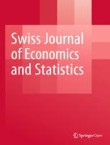The Swiss Journal of Economics and Statistics is published in collaboration with the Swiss Society of Economics and Statistics (SSES) and the Swiss Academy of Humanities and Social Sciences (SAGW). The journal is fully sponsored by the SSES and the SAGW so authors are not required to pay an article processing charge.
“Too shocked to search” The COVID-19 shutdowns’ impact on the search for apprenticeships
Even though the recession in Switzerland triggered by COVID-19 ultimately remained without consequences for the apprenticeship market, significantly fewer apprenticeship contracts had been signed in the months...
